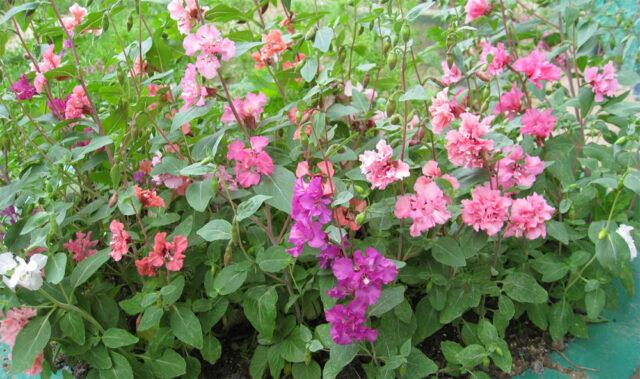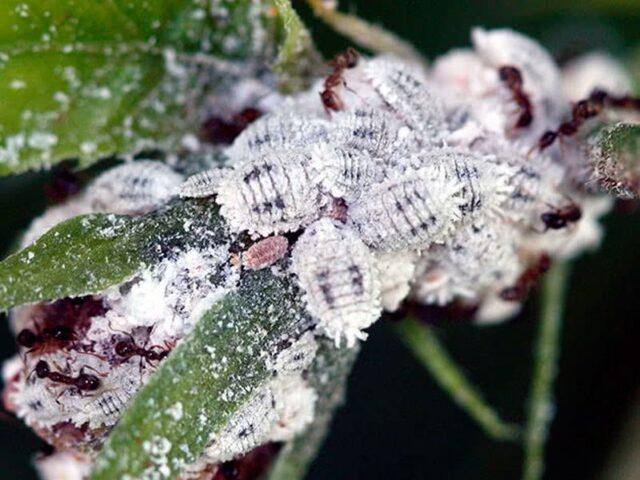Content
Clarkia is an ornamental plant with an annual life cycle. At a summer cottage, a flower can advantageously decorate the landscape, but it must be planted and grown in compliance with important rules.
Description of Clarkia
Clarkia is a herbaceous annual of the Willowweed family. It has erect branched stems, often with pubescence, and sessile elongated leaves of a bright green or bluish color. The plates are arranged in the same order.
Clarkia flowers are axillary, single or double. The shade may be white, pink, red-purple or lilac depending on the species. Most often, the buds are collected in racemes or spike-shaped inflorescences, sometimes they are single. The calyx of Clarkia is tubular, and the corolla of the plant is composed of four three-lobed or whole flowers.

Clarkia can grow up to 90 cm
In its natural form, the culture grows on the Pacific coast of the United States and in Chile.The flower is grown artificially all over the world, although out of several dozen varieties, only four are popular.
The difference between Clarkia and Godetia
Clarkia and godetia are very similar to each other and are considered closely related crops. However, there are significant differences between them:
- Clarkia reaches a height of up to 90 cm above the ground. Godetia stems rise up to a maximum of 40 cm.
- Clarkia has miniature flowers, no more than 3.5 cm in diameter, often located on the stem. Godetia buds are larger, up to 6-8 cm wide, with a satin surface of the petals.
Ornamental plants have similar growing requirements, so in the garden they are often placed in the same flower bed.
Types and varieties
Among the numerous varieties of clarkia, four varieties are the most famous and popular. They take root best in temperate climates and do not have high growing requirements.
Terry
The annual terry clarkia is not a species, but a whole group of varieties with lush inflorescences. It grows up to 36 cm above the ground and has branched stems with double buds up to 4.5 cm. The flowering is white, lilac or rich carmine, depending on the specific variety.

Terry clarkiya remains decorative for two months
Fantasy
Clarkia Fantasia is a seed mixture that allows you to grow flowers up to 75 cm tall. The buds of plants of this variety are axillary, most often double, less often simple. The color ranges from white to pale red and deep carmine.

Clarkia Fantasia blooms in mid-June
Pretty
Clarkia pulchella is a dwarf plant with erect stems.The leaves of the species are green, long and narrow, the flowers are simple, collected in several pieces at the tops of the shoots. The color of the petals is usually pink or lilac. The flowering of the crop begins in the third decade of June.

A pretty clarkia grows to an average of 40 cm
Graceful
Clarkia graceful, or marigold (Clarkia elegans), is a tall annual plant up to 1 m above the ground. It has thin but strong stems with woodiness in the lower part, bears flowers of double or single type from white to purple shades. The decorative period lasts from early July to September.

Graceful clarkia prefers planting in sunny places
Growing clarkia from seeds
Clarkia flowers are usually grown using the seedling method. This allows you to protect young plants from negative external conditions and transfer them to the ground after the annuals have become a little stronger.
When to plant clarkia seedlings
The sowing of crop seeds for seedlings is usually carried out in March. In this case, you can transfer the flower to open ground in June, after the final frosts have passed.
Clarkia sowing scheme
Before sowing plant seeds in closed containers, they must be treated against possible fungal diseases. To do this, planting material is immersed in a light pink solution of potassium permanganate for 15 minutes, and then dried from moisture on a paper towel.
The seed sowing scheme is as follows:
- A shallow but wide container is prepared for the plant.
- The container is filled with a nutritious, slightly acidic substrate with the addition of rotted manure, peat and river sand.
- Make small indentations at a distance of about 2 cm from each other.
- Sow seeds in holes and sprinkle soil on top.
- Spray the soil generously with a spray bottle and cover the container with glass or film.
Before germination, the container with seedlings is placed in a warm place without direct access to the sun. As soon as the clarkia germinates, you will need to remove the cover from it and move the box to a lighted windowsill.

The optimal temperature for growing clarkia seedlings is 20-22 °C
Seedling care
Growing seedlings at home does not involve any difficulties. Before planting in open ground, seedlings must be watered regularly as the substrate dries. The duration of daylight should be at least 12 hours, so if there is not enough sun, the plants need to be illuminated. When the first true leaves appear, the clarkia is plucked, leaving only the strongest seedlings with intervals of 6-8 cm between individual specimens.
Shortly before transplanting into open ground, the plant begins to harden off. To do this, the seedlings are taken out into the fresh air, first for a couple of hours, and then the duration of their stay outside is gradually increased.
Transplantation into open ground
Planting in open ground for the crop is carried out in May or June, depending on climatic conditions. Select a place for the flower that is well lit, with slightly acidic soil. The site is prepared a couple of weeks before planting the crop. If the soil is too alkaline, when digging, add 1.5 kg of peat and 60 g of sulfur per meter. Complex minerals such as nitrogen, phosphorus and potassium are also added to the soil.
The planting algorithm is as follows:
- Shallow holes are made in the prepared area.
- Grown-up seedlings are removed from the container not one at a time, but in small groups, preserving the earthen lump.
- Plants are planted in holes at a distance of 20-40 cm from each other.
- Fill the remaining voids in the holes with nutritious soil and water the area with clarkia.
Immediately after planting, a stick or rod must be installed near each hole. Clarkia's stems are thin and fragile, so they require support.

After planting, clarkia needs to be pinched to stimulate tillering.
Features of care
The flower does not have strict requirements for growing conditions. Caring for it is quite easy if you follow the basic rules.
Watering
The decorative crop responds positively to the addition of water, but does not like waterlogging. The annual plant is watered only in severe drought, twice a week. The rest of the time, the flower has enough natural precipitation. Watering is carried out using settled, lukewarm water; the liquid is added so that it is evenly distributed around the plant and does not accumulate near the stem.
After the next moistening, the soil at the roots of the clarkia needs to be slightly loosened. This prevents water stagnation and also improves oxygen access.
Top dressing
Clarkia needs feeding, but it is carried out only during the flowering period of the plant, once every two weeks. It is necessary to use complex mineral mixtures, for example, Raduga or Kemira preparations.
Organics are not used for clarkia. But to improve flowering rates, it is allowed to sprinkle the soil near the roots of the plant with wood ash.
Trimming
In the summer, Clarkia needs to be trimmed from time to time, removing faded buds. This allows you to extend the decorative period and ensure more luxuriant flowering.
Classical sanitary or formative pruning is not carried out for annual plants. With the onset of autumn, the bushes are simply cut flush to the ground, and shortly before the cold weather, they dig up the area, remove the remaining roots and burn them in a remote corner of the garden.
How to collect seeds
Plant seeds for planting next season do not need to be purchased in the store; they can be collected in the summer from adult bushes. By the end of the decorative period, it is necessary to wrap the largest and most spectacular buds in gauze or fabric bags.
About a month after the flower withers, the seed pods that have formed in its place will reach maturity. At this point, you can trim them, unfold the gauze or cloth over the spread newspaper and pour out the grains. After several days of drying, the seeds are poured into a paper bag and placed in a dark place for storage until spring.
Protection from pests and diseases
Decorative clarkia on the site may suffer from some fungal diseases and harmful insects. The danger to the plant is:
- mealybug - you can recognize the pest by a waxy coating on the leaves, similar to cotton wool;
Mealybug control is carried out using Aktara or Fitoverm
- rust - the fungus develops in conditions of waterlogging, manifests itself as yellowish-brown spots with a dark edging on the plates of the clarkia;
To remove rust, use Bordeaux mixture 1%
- downy mildew - with this disease, a light coating and discolored or dark round spots form on the underside of clarkia leaves;
The drug Fundazol or similar products allows you to cope with downy mildew
- flower midges - insects appear when there is excessive moisture and damage mainly the roots; pests can be eliminated using a solution of potassium permanganate or sulfur preparations.
Flower midge can harm clarkia even at the seedling stage
To prevent fungal diseases and parasites, you need to follow agricultural practices. Watering is carried out so that the soil does not remain waterlogged; the soil is regularly loosened and weeds are removed.
Photo of clarkia in landscape design
A low flower on the site is planted in artistic groups or in solo order. Most often the plant is used:
- for decorating paths;
Clarkia emphasizes the lines of paths in the garden
- for planting near walls and fences;
Clarkia helps to revive boring facades and fences
- in large flower beds;
In artistic groups you can combine multi-colored varieties of clarkia to create contrasts
When planting a crop in close proximity to other plants, you need to ensure that their requirements for agricultural technology coincide. If desired, you can also grow flowers in pots and vases on terraces and balconies.
Conclusion
Clarkia is a beautiful annual plant with small but bright flowers. The culture easily takes root in temperate climates, since in any case it does not go to winter. When growing, it is necessary to provide the plant only with regular watering and moderate feeding.















